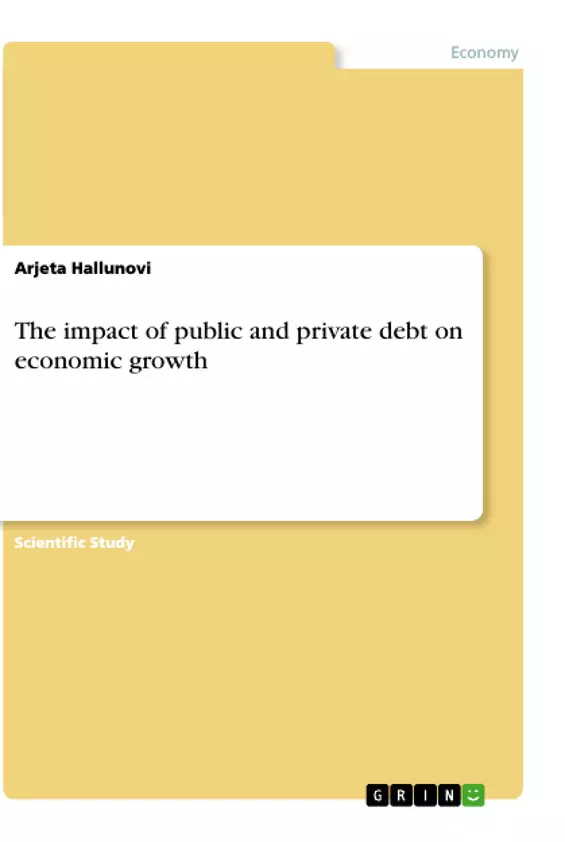This work aims to study the impact of public and private debt on economic growth in Albania during the period 2014 to 2018, as well as the main determining factors for both indicators. The methodology used is based on econometric regression analysis. The results showed that public and private debt has a statistically significant impact on economic growth in Albania. The author aims to answer the question: Does private and public debt have an impact on economic growth in Albania?
The purpose of this work is to analyze the effects of public debt and private debt on the country's macroeconomic indicators, especially the emphasis is on efficiency of public and private borrowing borrowing on GDP. The effects of public debt on GDP vary from one country to another, studying the factors that influence the emerging differences between these countries and made possible the comparison of private and public borrowing borrowing effect on the economy of any country. Following the goal, this work will focus on the necessity of state debt and how the state ensures that debt, the importance of private sector development and business role over private borrowing on the role of public debt and private borrowing growth economic situation of the country.
Albania has managed to maintain positive economic growth and macroeconomic stability over the past decade, but its high level of public debt, with an upward trend over the last three years, has been seen as a concern by many domestic and foreign economists. When it comes to debt, both public and private debt must be taken into consideration. Private debt analysis takes on particular importance because private debt is associated with financing business projects and increasing consumer demand, which serve economic growth and improve the country's macroeconomic parameters.
Inhaltsverzeichnis (Table of Contents)
- CHAPTER I
- INTRODUCTION
- GOAL AND OBJECTIVES
- CHAPTER II
- Introduction
- Review of the literature on the relationship public-debt growth
Zielsetzung und Themenschwerpunkte (Objectives and Key Themes)
This study aims to analyze the impact of both public and private debt on Albania's macroeconomic indicators, particularly focusing on the efficiency of public and private borrowing on GDP. The study examines the factors influencing the differences in the impact of public debt on GDP across various countries and compares the effects of private and public borrowing on the economy of any country.
- The necessity of state debt and how the state ensures that debt
- The importance of private sector development and the role of business in private borrowing
- The impact of public and private debt on economic growth
- The role of public and private borrowing in the economic situation of the country
- The future of lending to banks
Zusammenfassung der Kapitel (Chapter Summaries)
CHAPTER I: INTRODUCTION
This chapter focuses on the significance of sustainable economic growth, especially for developing countries like Albania, which faces challenges related to macroeconomic and political stability, unemployment, and EU membership. It emphasizes that economic growth is a crucial objective of macroeconomic stabilization due to its direct impact on living standards. The chapter explores the three economic tools available to governments (taxes, printing money, and debt) and the rationale for borrowing, particularly for long-term investments and counter-cyclical policies.
GOAL AND OBJECTIVES
This section outlines the study's purpose, which is to analyze the effects of public and private debt on Albania's macroeconomic indicators, specifically on GDP. The study aims to understand the factors contributing to variations in the impact of public debt on GDP across different countries and compare the effects of private and public borrowing on the economy.
CHAPTER II: LITERATURE REVIEW
This chapter provides an overview of the existing literature on the relationship between public debt and economic growth, as well as the relationship between private debt and economic growth. It examines different economic schools of thought on these relationships, including studies with conflicting conclusions.
Schlüsselwörter (Keywords)
This study focuses on the impact of public and private debt on economic growth in Albania. The main keywords and focus topics include: Albania, economic growth, private debt, public debt, regression analysis, macroeconomic stability, and financial crisis.
- Citar trabajo
- Arjeta Hallunovi (Autor), 2020, The impact of public and private debt on economic growth, Múnich, GRIN Verlag, https://www.grin.com/document/520336



